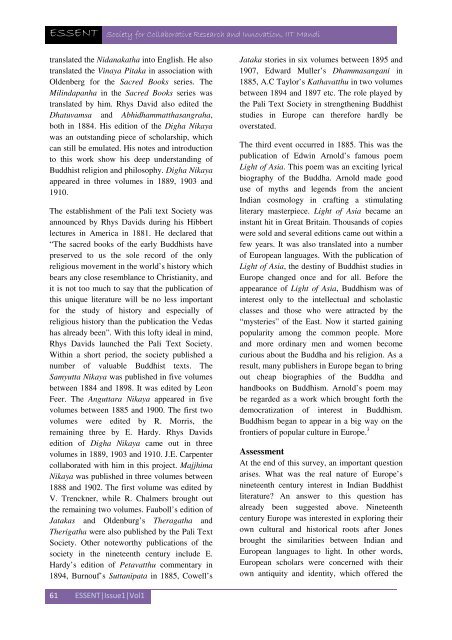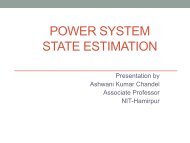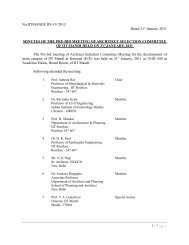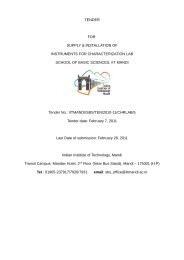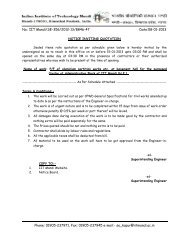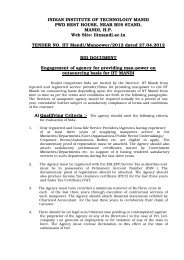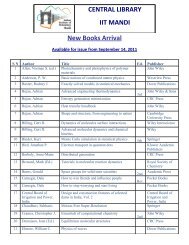Issue1. Vol.1 (April, 2013) - IIT Mandi
Issue1. Vol.1 (April, 2013) - IIT Mandi
Issue1. Vol.1 (April, 2013) - IIT Mandi
- No tags were found...
You also want an ePaper? Increase the reach of your titles
YUMPU automatically turns print PDFs into web optimized ePapers that Google loves.
ESSENT Society for Collaborative Research and Innovation, <strong>IIT</strong> <strong>Mandi</strong>translated the Nidanakatha into English. He alsotranslated the Vinaya Pitaka in association withOldenberg for the Sacred Books series. TheMilindapanha in the Sacred Books series wastranslated by him. Rhys David also edited theDhatuvamsa and Abhidhammatthasangraha,both in 1884. His edition of the Digha Nikayawas an outstanding piece of scholarship, whichcan still be emulated. His notes and introductionto this work show his deep understanding ofBuddhist religion and philosophy. Digha Nikayaappeared in three volumes in 1889, 1903 and1910.The establishment of the Pali text Society wasannounced by Rhys Davids during his Hibbertlectures in America in 1881. He declared that“The sacred books of the early Buddhists havepreserved to us the sole record of the onlyreligious movement in the world’s history whichbears any close resemblance to Christianity, andit is not too much to say that the publication ofthis unique literature will be no less importantfor the study of history and especially ofreligious history than the publication the Vedashas already been”. With this lofty ideal in mind,Rhys Davids launched the Pali Text Society.Within a short period, the society published anumber of valuable Buddhist texts. TheSamyutta Nikaya was published in five volumesbetween 1884 and 1898. It was edited by LeonFeer. The Anguttara Nikaya appeared in fivevolumes between 1885 and 1900. The first twovolumes were edited by R. Morris, theremaining three by E. Hardy. Rhys Davidsedition of Digha Nikaya came out in threevolumes in 1889, 1903 and 1910. J.E. Carpentercollaborated with him in this project. MajjhimaNikaya was published in three volumes between1888 and 1902. The first volume was edited byV. Trenckner, while R. Chalmers brought outthe remaining two volumes. Fauboll’s edition ofJatakas and Oldenburg’s Theragatha andTherigatha were also published by the Pali TextSociety. Other noteworthy publications of thesociety in the nineteenth century include E.Hardy’s edition of Petavatthu commentary in1894, Burnouf’s Suttanipata in 1885, Cowell’sJataka stories in six volumes between 1895 and1907, Edward Muller’s Dhammasangani in1885, A.C Taylor’s Kathavatthu in two volumesbetween 1894 and 1897 etc. The role played bythe Pali Text Society in strengthening Buddhiststudies in Europe can therefore hardly beoverstated.The third event occurred in 1885. This was thepublication of Edwin Arnold’s famous poemLight of Asia. This poem was an exciting lyricalbiography of the Buddha. Arnold made gooduse of myths and legends from the ancientIndian cosmology in crafting a stimulatingliterary masterpiece. Light of Asia became aninstant hit in Great Britain. Thousands of copieswere sold and several editions came out within afew years. It was also translated into a numberof European languages. With the publication ofLight of Asia, the destiny of Buddhist studies inEurope changed once and for all. Before theappearance of Light of Asia, Buddhism was ofinterest only to the intellectual and scholasticclasses and those who were attracted by the“mysteries” of the East. Now it started gainingpopularity among the common people. Moreand more ordinary men and women becomecurious about the Buddha and his religion. As aresult, many publishers in Europe began to bringout cheap biographies of the Buddha andhandbooks on Buddhism. Arnold’s poem maybe regarded as a work which brought forth thedemocratization of interest in Buddhism.Buddhism began to appear in a big way on thefrontiers of popular culture in Europe. 3AssessmentAt the end of this survey, an important questionarises. What was the real nature of Europe’snineteenth century interest in Indian Buddhistliterature? An answer to this question hasalready been suggested above. Nineteenthcentury Europe was interested in exploring theirown cultural and historical roots after Jonesbrought the similarities between Indian andEuropean languages to light. In other words,European scholars were concerned with theirown antiquity and identity, which offered the61 ESSENT|Issue1|Vol1


